
The JAXA Usuda Deep Space Center in Saku, Nagano Prefecture, is home to the largest parabolic antenna in Japan. This large antenna, 64 meters in diameter, was built in 1984, and it was used to communicate with Japan’s first two interplanetary space probes, Sakigake and Suisei, which were launched to study Halley’s Comet in 1985. The antenna has since handled communications with the asteroid probe Hayabusa and other deep-space probes. It is now being used to communicate with the Venus probe Akatsuki and the asteroid probe Hayabusa 2. Today, however, the antenna’s age has become an issue – it is now more than 30 years old – and a new antenna is planned for completion by the end of JFY 2019.
Developing a New Parabolic Antenna
— Tell us about the GRound station for deep space Exploration And Telecommunication (GREAT) Project.
 Conceptual image of the new antenna (courtesy of Mitsubishi Electric)
Conceptual image of the new antenna (courtesy of Mitsubishi Electric)
We are building a new parabolic antenna to succeed the aging 64-meter one at the Usuda Deep Space Center, and to increase downlink capacity for the next period of deep-space exploration. The GREAT project team was set up officially in November 2015 for that purpose.
— What kind of antenna is being planned?
The new antenna will be 54 meters in diameter and will communicate with space probes in the X band (8 GHz) and Ka band (32 GHz). The antenna will be located in a national forest along the Tateshina Skyline road, about 1.3 km in a straight line from the existing antenna.
— Why was this location chosen?
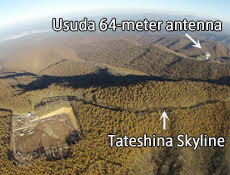
 Preparation of the planned construction site for the new antenna (courtesy of Takehana-Gumi)
Preparation of the planned construction site for the new antenna (courtesy of Takehana-Gumi)
Radio signals from probes navigating deep space are extremely weak. That’s why antennas are constructed in remote areas, where there is less interference from radio waves emitted by TV stations, mobile phones, etc. We chose the location where the antenna can pick up weak signals from probes. Think of this as someone trying to whisper to you from across the room when you’re surrounded by a group of noisy people. It would be easier to hear if you were somewhere quiet, right? Other reasons for choosing this site were relatively little rain, which weakens radio signals; accessibility for construction vehicles thanks to a well-maintained road; and the local support, as we already have a facility nearby. Some local people did wonder why we couldn’t build the new antenna at the Usuda Deep Space Center, where the existing antenna is located. Due to their size, it was necessary to separate the antennas enough to ensure that there would be no signal interference.
— How is development proceeding?
The basic design of the overall system, including the antenna, was finished in early October 2016, and we’re working toward completion in JFY 2019. At present, site preparation is underway and detailed blueprints are drawn up. The antenna is going to weigh roughly 2,100 tons. Groundwork for the concrete foundation that will support that weight is set to start in April 2017, with assembly of the antenna itself scheduled to begin a year later. Due to snow, we cannot do any outdoor work during the four winter months, from December to March, but we still hope to be finished and operational in time for Hayabusa 2, though that is a pretty tight schedule. Hayabusa 2 is currently on its way to the asteroid Ryugu, and is expected to arrive in mid-2018, before leaving the asteroid in late 2019.
A High-Performance Antenna Using the Latest Technology
— The new antenna will have a diameter of 54 meters, which is smaller than the existing antenna at Usuda. What reception capabilities will it have?
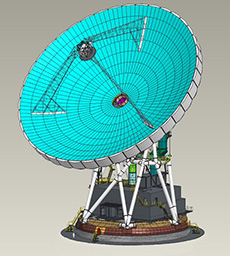 Conceptual drawing of the new antenna (courtesy of Mitsubishi Electric)
Conceptual drawing of the new antenna (courtesy of Mitsubishi Electric)
The new antenna’s primary reflector will be 54 meters in diameter for financial reasons. The existing antenna is 64 meters in diameter, and its aperture has roughly the surface area of 12 tennis courts. The surface area of the new antenna will be closer to nine tennis courts. Although the antenna’s capacity to receive signals will scale down by 30 percent, we are taking steps to compensate for this and maintain receiving performance.
One way of doing this is to increase the mirror surface precision of the primary reflector, which will improve receiving performance by a factor of 1.6 over the existing antenna. Radio waves cannot be collected properly if the reflector has an irregular surface, but if the entire reflector is finished to the same degree of smoothness, that enables radio waves to be properly concentrated on the focus, and receiving performance is improved. Surface imperfections on the new antenna’s primary reflector will be no more than 0.6 mm, which is less than the thickness of a credit card. An antenna this size will be deformed just from being moved or jostled – even from wind or changes in temperature. So to make sure the new antenna works as precisely as possible, we wanted to use mature technology that has been tested in the field. Japan was responsible for the development of some of the parabolic antennas used in the ALMA telescope in Chile, which was completed in 2013. Some of that technology will be incorporated into this new high-performance antenna.
— If a smaller antenna can now provide the higher performance as the older, bigger one, that means technology must have improved a lot in the past 30 years.
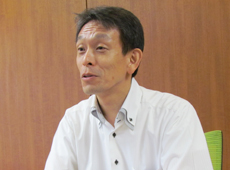
Yes. The new antenna will also have better pointing accuracy. Pointing accuracy refers to how accurately the antenna can be pointed at a space probe. The role of a parabolic antenna in this respect is to track and control satellites and probes using radio waves. An antenna must be able to accurately point at satellites and probes, precisely determine their position and attitude, check the state of their onboard instruments, and control them by sending command data whenever required. Now you see the degree of precision this requires. The new antenna will be able to point at a space probe with the same degree of accuracy that it would take to shoot a target roughly 40 cm in diameter from a position 2.4 km away.
The existing antenna works on the S-band (2 GHz) and X-band (8 GHz) frequencies; the new one will use the X-band and Ka-band (32 GHz) frequencies. The high-frequency Ka band is suited to high-capacity transmissions. This is why recent deep-space probes from NASA and ESA (European Space Agency) currently communicate on it. At the same time, because the Ka band has a shorter wavelength, the antenna beam is four times narrower than that of X-band frequencies. Therefore, in order to track our probes accurately, we have to increase our antenna’s pointing accuracy. I guess it could be said that we are also able to use the Ka band today because of advances in Japanese technology.
— Ka-band frequencies are also used on Hayabusa 2, right?
Hayabusa 2 is also equipped with a Ka-band antenna. However, as Japan does not yet have any ground stations that can use Ka band frequencies to communicate with space probes, at the moment we use NASA’s ground stations. Once the new antenna is completed and starts communicating with Hayabusa 2, we will be able to receive twice as much data as before. The new antenna should also play a major role in communicating with the Mercury probe scheduled to be launched in cooperation with ESA in 2018.
Operating Deep Space Probes Without Interruption
— Tell us about the history of the Usuda Deep Space Center.
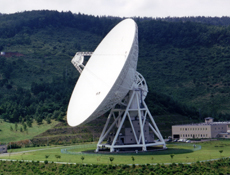 Usuda Deep Space Center’s 64-meter parabolic antenna
Usuda Deep Space Center’s 64-meter parabolic antenna
The Usuda Deep Space Center was established about thirty years ago as the only ground station in Japan for deep-space probes. It has been involved in tracking and controlling all of Japan’s space probes, from the Halley’s Comet probes Sakigake and Suisei, which were the first probes launched by Japan into interplanetary orbit, to the recent lunar orbiter Kaguya, the asteroid probe Hayabusa and the Venus probe Akatsuki. I don’t think it was until the missing Hayabusa probe was rediscovered after three months that the role of the Usuda antenna became widely known. At the time, I heard that the center had been carefully searching for faint signals from Hayabusa every day, not knowing when it would re-appear. The center has also helped the tracking and control of NASA’s Voyager probes and so on.
You have convinced us that the antenna at Usuda is essential for the deep-space exploration.
It has been supporting the deep-space exploration program for more than 30 years. But it has exceeded its design life by more than ten years, and some of its components cannot be repaired. We need the new antenna to ensure the reliable and uninterrupted operation of deep-space probes now and in the future. I just mentioned the rediscovery of the Hayabusa probe. I believe that was possible only because there was a ground station in Japan.
— What difficulties have you experienced so far?
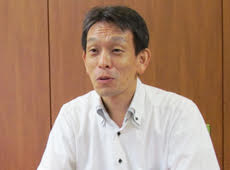
We don’t have anyone on our team who worked on the development of the old Usuda antenna, and without that experience we often face issues that are difficult to overcome. In particular, I was not involved in the preparation phase prior to the launch of the project, so at times it has been extremely difficult to balance the demands of the user side – the probe teams – with the pressure from management to reduce costs, while working within the confines of a budget. We understand the need to maximize antenna performance so we can accurately receive large amounts of observation data from space probes. But I believe that a project’s value stems from attaining its goals within the restrictions of its resources. This is a fundamental principle of project management, but for me, in the position of responsibility, it has been a real struggle to achieve this in practice.
— What plans are there for the future?
We experienced many birth pangs during the first year of the project, but we were able to complete the preliminary design successfully, with the support of Saku City and many others. Now, while maintaining the principles of project management, we want to do our best to ensure the project’s success. Our project team consists of researchers and engineers from two different workplaces: the Institute of Space and Astronautical Science in Sagamihara, and the Tsukuba Space Center. I hope that we can learn to work more effectively as a team and to compensate for one another’s weaknesses. If each of us can harness the spirit of teamwork, I’m sure we will be able to accomplish our goal. I have learned from experience that it is important to face any difficulties with a positive attitude, no matter what has happened. Yes, there will probably be many unanticipated problems throughout the project, but we have no choice but to confront them one at a time. Bearing this in mind, we are working toward the successful completion of the new antenna.
Although attention is usually focused on the achievements of probes in space, these could not function without the support of ground stations. I would be delighted if everyone knew about JAXA’s ground-based projects such as this one.
Kenji Numata

Project Manager, JAXA Ground Station for Deep Space Exploration and Telecommunication Project
After graduating from the National Kumamoto Radio Technical College, he joined NASDA (now JAXA) and was appointed to the Masuda Tracking and Communication Station on Tanegashima Island. Subsequently, after holding positions at the Tracking and Control Center at the Tsukuba Space Center, the Space Technology Directorate II, and the Chief Engineer’s Office, he was appointed Head of the Pre-Project Team for the GREAT Project in July 2015. He has held his current position since November 2015.
[Jan 12, 2017]